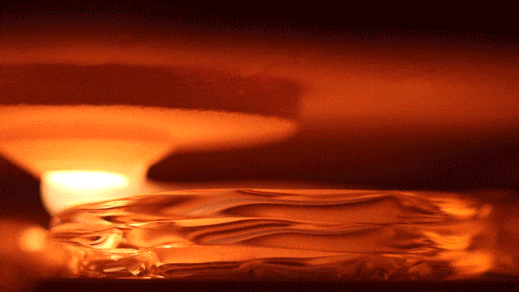One of the reasons we favored the European 3D companies during the great infatuation was their ability to work in more difficult mediums than the American co's:
Swedish 3D Printer Arcam AB: Small Company with Big Growth Projections (AMAVF)
Here's some more bleeding edge. From the Massachusetts Institute of Technology, using glass at 1900° F as the 'ink':We've looked at Arcam a couple times, they are one of the class acts in 3D printing metals. From $10.28 last September the U.S. traded ADR's are up to $66.48.The ADR's are now at $ 91.95 up another $1.40 on the day. Yeah, you're reading that right, up another 38% since I got all chicken less than two weeks ago.
They are also very tiny; despite the sixfold run the company's market cap is less than $300 million.
That combination, big run up yet small cap puts this in a much higher risk category than the megacaps we usually talk about on the blog. In fact this may be a situation where chasing is just plain dangerous....
Despite my concern about the share price the company itself is a little gem, one of the leaders in 3D metalworking as opposed to the plastic tchotchkes that you get out of a MakerBot. And not just any kind of metalworking either, this is bleeding edge....

August 20 2015
Mediated Matter Group in collaboration with MIT's Department of Mechnical Engineering and MIT's Glass LabAncient yet modern, enclosing yet invisible, glass was first created in Mesopotamia and Ancient Egypt 4,500 years ago. Precise recipes for its production - the chemistry and techniques - often remain closely guarded secrets. Glass can be molded, formed, blown, plated or sintered; its formal qualities are closely tied to techniques used for its formation. From the discovery of core-forming process for bead-making in ancient Egypt, through the invention of the metal blow pipe during Roman times, to the modern industrial Pilkington process for making large-scale flat glass; each new breakthrough in glass technology occurred as a result of prolonged experimentation and ingenuity, and has given rise to a new universe of possibilities for uses of the material. This show unveils a first of its kind optically transparent glass printing process called G3DP. G3DP is an additive manufacturing platform designed to print optically transparent glass. The tunability enabled by geometrical and optical variation driven by form, transparency and color variation can drive; limit or control light transmission, reflection and refraction, and therefore carries significant implications for all things glass. The platform is based on a dual heated chamber concept. The upper chamber acts as a Kiln Cartridge while the lower chamber serves to anneal the structures. The Kiln Cartridge operates at approximately 1900°F and can contain sufficient material to build a single architectural component. The molten material gets funneled through an alumina-zircon-silica nozzle. The project synthesizes modern technologies, with age-old established glass tools and technologies producing novel glass structures with numerous potential applications.
The G3DP project was created in collaboration between the Mediated Matter group at the MIT Media Lab, the Mechanical Engineering Department, the MIT Glass Lab and the Wyss Institute. Researchers include : John Klein, Michael Stern, Markus Kayser, Chikara Inamura, Giorgia Franchin, Shreya Dave, James Weaver, Peter Houk and Prof. Neri Oxman. ...
